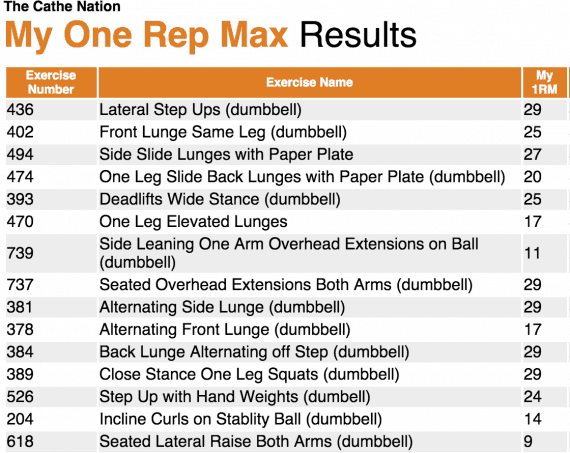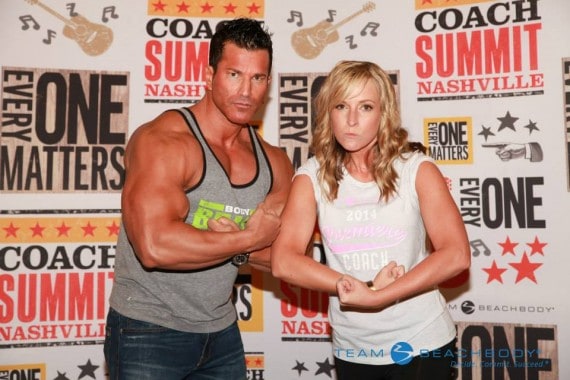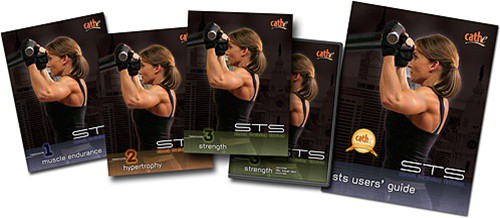How to Find Your One Rep Max: Workout & Exercises
This post may contain affiliate links. All opinions shared are my own. As an Amazon Associate I earn from qualifying purchases. Click to view our full disclosure.
Have you ever struggled to know what weight to use when you’re strength training? Finding your One Rep Max (1RM) helps you find the best weight to use in your strength training for max results.
If you’ve been lifting weights for awhile, it’s time to find out your numbers.

The really cool part of it is that using the One Rep Max can also help you easily and more accurately adjust your weights used when you varying your amount of reps as well.
I started testing my One Rep Max (1RM) about 14 years ago when I started powerlifting 3x a week with Cathe Friedrich’s STS.
What is a One Rep Max (1RM)?
Your one rep max (1RM) is the heaviest weight you can lift for one repetition of an exercise. Each exercise move needs to include proper form and a full range of motion.
Using your 1RM for each exercise, you can figure out your weight selection and number of reps needed for your workout.
Your 1RPM will vary for each exercise performed and muscle used. For example, you 1RM will be different for a deadlift compared to a squat or bench press.
Why is it worth finding your 1RPM?
Finding your one-rep max is a great way to track your progress and if you’re getting stronger.
By knowing your max, you can choose an effective weight for each workout move. This can help you get a more effective workout and greater results even without a personal trainer pushing you each rep.
The goal of effective strength training for gaining muscle is to be 1-3 reps shy of muscle failure.

Who is One Rep Max Training for?
If you are just getting into working out or strength training, 1RM isn’t for you. You’ll want to focus on using good form and learning the right exercises for each muscle group.
A recent study showed that it can actually be dangerous for beginners to try to find their max because their form isn’t perfected yet (source).
Also, if you’re just occasionally lifting weights, there really isn’t any point either. You’ll still see great results if you’re feeling challenged during your last 2-3 reps.
If you’re considering 1RM testing, we recommend reaching out to a professional or fitness trainers. They can help you with repetition maximum tests, using good technique, and help with lowering the risk of injury.
Fitness instructors can also help you create custom routines for your specific goals.
So who should use 1RM?
You should look into your 1RM if you’re an advanced lifter that knows how to use good form even with heavy loads. Using your 1-rep max can help you get stronger and bump up to heavier weight over ttime.
It’s also helpful if you’re workout program is calling for percentages. For example, lift 80% of your 1 rep max.
What About the Tempo of Weight Training?
One Rep Max works for a pace of 2 seconds up and 2 seconds down of one strength move. If you vary the speed of your rep, this technique won’t work.
In terms of recovery or rest time between exercises. You need at least 30 seconds between endurance exercises (reps over 15), 60 seconds between hypertrophy exercises (10-12 reps) and 3 to 5 minutes between strength exercises (6 or fewer reps). (source)

How do I find my one rep max?
Note: It can be very dangerous to just load up a heavyweight and see if you can lift it. There’s a better way.
The American College of Sports Medicine (ACSM) offers one way to estimate the 1RM, usually for multi-joint exercise like the bench press or squat.
- Multiply the number of reps you can perform for an exercise to failure by 2.5, for example, a weight you can lift around 10 times
- Now subtract that number from 100. This will determine the percentage of your one rep max.
- Divide that number by 100 to get a decimal value
- Divide the weight you lifted by the decimal value to get your approximate one rep max.
Best 1 Rep Max Exercises
It’s recommended by the ACSM to focus on a compound exercise, like the bench press or squat, for your 1 rep max testing.
Here is an example of a 1 rep max workout routine test:
- Squat
- Bench press
- Deadlift
- Overhead Press
- Romanian deadlift
- Sumo deadlift
- Front Squat
- Pull up or chin up
You don’t have to do every exercise known to man to find your one rep max. These specific one max exercises target multiple muscle groups.
For example, the bench press targets not just your chest but your shoulders and triceps as well. If you bench press 1RPM max increases, you can also know that your triceps and shoulders have gotten stronger.
Using a One Rep Max (1RM) Calculator
A calculator is another quick and easy way to find the perfect 1RM workout exercises.
Here is an online 1RM calculator.
In the past, we used one provided by Cathe. Here’s a sample of what my One Rep Max Results looked like using hers.

What Does Using Your One Rep Max (1RM) In a Workout Look Like?
Let’s say you take a One Rep Max test for barbell rows and your One Rep Max 100 lbs.
It’s simple to find your best weight to use during your strength workout:
- A warm up set you should use a weight of about 50% of your 1RM (.50 x 100 lbs = 50 lbs). Thus you should use 50 lbs in your warm-up set.
- 15 reps you should use 70% of your 1RM (.70 x 100 lbs = 70 lbs). Thus, you should use 70 lbs if you want to do 15 reps
- 8-10 reps you should use 80% of your 1RM (.80 x 100 lbs = 80 lbs). Thus, you should use 80 lbs if you want to do 8-10 reps
- 4 reps you should use 90% of your 1RM (.90 x 100 lbs = 90 lbs). Thus, you should use 90 lbs if you want to do 4 reps
Using Your One Rep Max in Workouts
Whether you’re working out at the gym or at home, there are plenty of ways to use your one rep max in workouts.
We’ve used the One Rep Max technique for our home programs including LIIFT4, P90X, and Body Beast.
You can also stick to any workout with a progressive overload.
This means you’ll be doing the same exercises each week, but you’ll use your percentages of your 1RM to know which weights to use. Each week, you’ll up the weights.
Example of a progressive strength workout using percentages of your 1RM:
- Week 1: Test your 1RM in the bench press, deadlift, and barbell row.
- Week 2: Bench press, deadlift, and barbell row for 3 sets of 5 reps using 85% of your 1RM from week 1.
- Week 3–5: Try to increase the weights for each move by 5–10 pounds OR try to add in 2-3 reps each week.
- Week 6: Re-test your 1RM and repeat.
The One Rep Max principle is also used in Power Lifting.
Powerlifting, often confused with Olympic lifting, is an individualized sport in which competitors attempt to lift as much weight as possible for one repetition in the squat, bench press, and deadlift. (Source)
If you were powerlifting, your one rep max would be what you would lift for each exercise move, but the concept can be used in any strength workout!

Why Does the One Rep Max Work?
It allows you to know exactly what weight you should be using even when your number of reps change because it uses a percent of your 1RM.
How Often Should I do a Test?
After your initial rep-max test, we recommend setting some training goals and committing to a specific training program that offers some progressive overload for maximum strength gains.
After you complete your training plan, or within 2-4 months, you can retest. This will allow you to identify any progress and strength gains you’ve had and continue to push your limit.
Tips for Testing
We recommend keeping your test environment as close to the same as possible every time. This will help you see your true increases in strength.
For example: If you ate a meal 30 minutes before testing the first time, eat the same meal 30 minutes ahead of retesting. The same thing can be said about the exercise selection, getting into the right headspace or taking the sample supplements.
We also always recommend warming up before testing and always have a spotter. This can help with safety, and the spotter may also be able to watch your form.

Workouts to Increase Your One Rep Max at Home
I highly suggest Cathe Friedrich’s STS or Joel Freeman’s LIIFT4.
You only need a variety of weights for LIIFT4, and the equipment you need for STS is pretty minimal, too. We use the SelectTech weights from Bowflex.
If you are looking for a great strength workout at home, we recommend LIIFT4.
The workouts are 30-40 minutes long, and you lift heavy weights for 10 reps.
With that said, we would recommend repeating the same LIIFT4 Week 1 workouts 4-6 times for a more true progressive overload training program. Since the workout program includes 8 weeks of workouts, you could essentially do the program for a year if you mixed in a recovery week every quarter or so!
If you’re okay with an hour long workout, Cathe Friedrich’s STS is a great program, and it can be done as-is!
It is a very high quality at home workout program with amazing attention to detail and proper form.
It includes 36 different workouts and is a 3 phase system.
Each mesocycle is created to challenge the body for max results.
While it’s very scientific in how it was designed, the program is easily laid out for you to follow. You can follow along at home with the DVDs or take your workout sheets to the gym.
Each week combines new and previous weeks’ moves to keep you challenged and your muscles guessing.
It focuses on getting maximum results at home using the 1 Rep Max System.
Cathe’s STS incorporates different training aspects for MAX results.
You’ll focus on:
- Periodization
- Muscle Confusion
- One Rep Max
- Progressive Overload
Over the 3 or 6 months, you follow the program. You can also repeat it and see your strength improve.
She also has a new version, STS2.0, but I’ve not tried it.

Why I Love the One Rep Max…
I love using this technique because it takes the mental battle out of it. I can look at my 1RM for each move and figure the percentage to know what I can lift instead of having to think – is this going to be too heavy?
Using the 1RM technique has made me lift heavier than I ever thought I could and gave me the confidence to try it because of the science behind it.
Plus, I know I’m working as hard as I can. Another perk is knowing the weight to lift ahead of time saves me time in between strength moves.

Will Using Your One Rep Max Bulk You Up?
No way! Using the right weight based on your One Rep Max is going to give you results faster, but your muscle mass depends on your genetics, diet, and the type of exercise you are doing.
Your reps will depend on how much mass you put on as well – endurance training (15-20 reps) will give you the leanest muscle, hypertrophy training (10-12) builds muscle, and strength moves (6 or fewer reps) builds the most muscle mass.
I’ll never have arms like Sagi because I’m a woman, don’t eat or lift as heavy at a low rep like he does.
You may also like Strength Training: Women’s Guide to Toned or Sculpted Muscle
LEARn MORE ABOUT CATHE FRIEDRICH’S STS PROGRAM
Learn More About LIIFT4
We hope this guide has helped you figure your one rep max, as well as, feel empowered by the opportunity to continue towards your personal best!
After all, building muscle is important at all different age groups, but it’s especially important for older adults because we lose muscle as we age. Using the one rep max technique, you can ensure you get the best results and track your muscle gains in a most accurate way.
Will or do you use the One Rep Max Technique in Strength Training?
Updated February 2024
I am not a certified personal trainer or medical professional. The information provided is for informational purposes only. Consult a qualified medical professional before starting any new exercise program, as all fitness activities carry inherent risks. By engaging in these activities, you assume responsibility for any associated risks or injuries.





